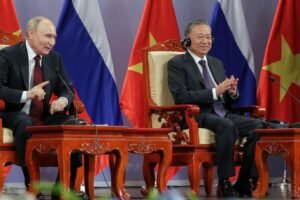“We need to leverage expertise from the United Kingdom and the United States to help us along our optimal pathway – and building capability with them means we are better able to shape, deter and respond within our strategic landscape,” Australian Defense Minister Richard Marles said.
SYDNEY and BELFAST — With the formal announcement of Australia’s path to obtain nuclear attack submarines expected to happen in Washington next month, speculation about the likely solution AUKUS is beginning to leak out.
The most intriguing hints center on a British boat — but not the Astute-class — based in part on rare public comments by Australian Defense Minister Richard Marles and his British counterpart, UK Defence Secretary Ben Wallace.
Marles said Monday in Canberra that an announcement on Australia’s preferred option was “not far off,” and would be a “genuine three-way collaboration” between Australia, the UK and US. “I think when you see what is ultimately unveiled, it is the three countries working really closely together.”
Adding some detail to the discussion in a prepared Thursday speech before the Australian House of Representatives, he defended the likely high quantity of foreign content in the new subs, noting that almost all major Australian weapon systems depend on foreign content.
“Some argue that Australia’s reliance on our partners for the acquisition of naval nuclear-propulsion technology gives rise to a dependence that undermines Australia’s sovereignty,” Marles said. “Yet the reality is that almost all of Australia’s high-end capability is developed in cooperation with our partners. Submarines are no exception. And that dramatically enhanced capability dramatically enhances our sovereignty.
“We need to leverage expertise from the United Kingdom and the United States to help us along our optimal pathway — and building capability with them means we are better able to shape, deter and respond within our strategic landscape,” Marles added.
From the first announcement of the AUKUS effort, Australia has said it intends to build boats at home. However, developing the nuclear expertise from a tiny pool of a few dozen individuals to potentially thousands of people will take time, as will development of the highly skilled welders and other technical experts needed to build and maintain nuclear powered boats. Developing a new design and building a new shipyard to produce it seems unrealistic, given the lack of domestic expertise — especially if the goal is to deploy nuclear attack submarines before the conventionally powered Collins-class attack subs are retired.
That has prompted talk of America supplying Australia with refitted Los Angeles-class boats or providing Virginia-class boats that would be crewed by Australians, but both options pose many obstacles. America doesn’t seem able to build nuclear attack boats quickly enough to meet its stated requirement of 66, which prompted two top defense lawmakers in the Senate to caution President Joe Biden against committing the US to supplying Australia with nuclear boats.
Given the concerns about personnel and Marles’ comments, there is reason to think Britain’s next-generation sub, which will require a much smaller crew than do any of the American boats are in play.
Nick Childs, a naval expert at the International Institute for Strategic Studies, touted the prospects of the UK’s next-gen sub in a piece published on Jan. 23.
“However, there have recently been indications that a design based more on the UK’s planned next-generation submarine, currently dubbed SSNR, has been finding favour, and could potentially be developed further under AUKUS. This may ultimately be the foundation for the plan that eventually breaks surface,” Childs wrote.
“Among the ‘straws in the wind’ are the UK’s ambitions to rebuild its own submarine fleet. The Royal Navy would like to see a rise from the planned seven Astute-class attack submarines to perhaps 12 boats in the long term. In a speech in December 2022, the UK chief of the defence staff, Admiral Sir Tony Radakin, said of AUKUS that ‘if we have the courage to do this properly’ it could help grow the UK’s own submarine numbers in the decades to come, clearly assisted in part by potential economies of scale under AUKUS.”
Australia’s conventionally powered Collins-class boats rely on a crew of 58, compared to 143 for the nuclear US Virginia-class and 98 for Britain’s Astute-class subs. Australia has found it challenging to find, train and retain sub crews for the smaller subs.
British Options On The Table
During his Feb. 1 appearance with Marles, Wallace, the UK’s defense secretary, appeared to offer some evidence for the UK next-gen sub, saying the AUKUS boats would be a: “joint endeavor. Whether that is the sharing of technology and the understanding of how to do it, the sharing of the build, or the sharing of the design — whatever option is chosen by Australia, it will be collaborative.”
Back in November 2021, the man who led the day-today work on the AUKUS boats in Australia, Vice Adm. Jonathan Mead, told an Australian Senate committee that his country intended to select a “mature design” for its nuclear submarine. “It is our intention,” Mead said then, “that when we start the build program, the design will be mature and there will be a production run already in existence.” That would appear to make the British offering a candidate.
“I think the major problem Australia has to face up to is that the infrastructure and regulatory architecture required to deliver a SSN [nuclear powered attack submarine] in the mid-2030’s means it has to collaborate with a foreign partner, initially at least,” Sidharth Kaushal, a sea power expert at the Royal United Services Institute think tank, told Breaking Defense.
“The point of friction that introduces with the UK [revolves around] the Australians operating with the US Navy primarily in the Indo-Pacific and their preference for things like prompt strike capabilities, including cruise missiles and potentially hypersonic missiles. The [US Navy] Virginia-class payload module can host those weapons but the [Royal Navy’s] Astute-class can torpedo launch cruise missiles but doesn’t necessarily offer prompt strike capabilities.”
All seven Astute-class submarines are due to be in service with the Royal Navy by 2026, each with a life cycle of 25 years.
“Even if you don’t know exactly what SSNR requirements looks like now, you know that certain modules, certain sensors, certain things would be necessary to integrate on it, so in principle you could create a sort of tri-national production line to build components of it and generate efficiencies of scale,” said Kaushal.
In September 2021, the UK MoD awarded two contracts both worth £85 million to BAE Systems and Rolls-Royce for SSNR design and concept work, intended to “inform a future decision” regarding which program development approach to take. Britain announced roughly a quarter of a billion dollar investment in the Submersible Ship Nuclear Replacement two days after the AUKUS project was announced.
So far, foreign industrial partners have not been contracted for SSNR activities but a fully collaborative approach with AUKUS partners has been touted by Wallace stretching back to September 2022.
“There’s much more work to be done when you look at areas of joint production…but for the initial project of delivering a new Australian submarine there’s going to be some compromises,” Kaushal said. “For the US, this works out quite nicely but their big challenge of course remains, that their production lines are struggling to meet US Navy requirements.”
Should the Virginia-class be selected for the Australian requirement, the US would also benefit from new basing facilities for the future submarines, he added.
“It would effectively give the US an additional SSN base separate to Guam, which is of course an inherently vulnerable location and will be more so going forward,” Kaushal explained.
Operationally, how the future Australian submarines operate in the Indo-Pacific looks to be particularly difficult to assess in light of China formidable ASW capabilities, like Type 56 Corvettes and Y-8 maritime patrol aircraft, combined with the often shallow waters of the South China Sea which can make nuclear submarine missions more difficult.
“China is investing in a pretty substantial sensor network in the South China Sea that includes under sea hydrophones, large unmanned underwater vehicles all linked up to artificial islands they have built,” Kaushal said.
On that basis, he suggested that Australia does “not necessarily” have to operate the SSN from the South China Sea in order to counter Chinese aggression, but could use the vessels as cruise missile launch platforms outside of it.
Regardless of whether the new subs come online in time to replace the Collins-class, US Defense Secretary Lloyd Austin pledged on Dec. 7 that the US “will not allow” a capability gap to appear between Australia’s Collins class sub retirement planned for 2039 and the deployment of its first nuke powered attack subs.
Kurt Campbell, head of Indo-Pacific issues on the US National Security Council, has said the three countries will increasingly fund their forces “almost melding.”
“We will have more British sailors serving on our naval vessels, Australians and the like on more of our forward-deployed assets in Australia. This leads to a deeper interconnection and, almost a melding in the new respects of our services and working together on common purpose that we couldn’t have dreamed about five or 10 years ago,” Campbell said in November 2021.
source: breakingdefense












